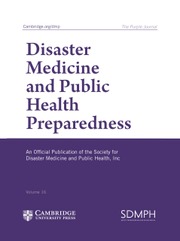Dear Editor,
As the world continues to grapple with the aftermath of the COVID-19 pandemic, the specter of future pandemics looms large. Emerging evidence suggests that climate change is not only an environmental crisis but also a significant driver of infectious disease dynamics. The interplay between climate change and disease emergence presents a complex challenge that demands urgent attention.Reference Pfenning-Butterworth, Buckley and Drake1 This editorial explores the potential for climate change to catalyze the next pandemic and outlines adaptive measures to mitigate this looming threat.
The Climate-Disease Nexus
Climate change is altering ecosystems, shifting weather patterns, and disrupting the delicate balance of natural habitats. These changes are creating conditions conducive to the emergence and spread of infectious diseases. Rising temperatures, altered precipitation patterns, and extreme weather events are expanding the geographic range of disease vectors such as mosquitoes, ticks, and rodents.Reference Ali, Shaikh and Sethi2 For instance, the spread of diseases like malaria, dengue fever, and Lyme disease is increasingly linked to climate-driven changes in vector habitats.Reference Tohit, Aidid and Haque3
Moreover, climate change is exacerbating the frequency and intensity of zoonotic spillover events—where pathogens jump from animals to humans.Reference Bhatia, Sonar and Khan4 Deforestation, habitat fragmentation, and biodiversity loss, all accelerated by climate change, force wildlife into closer contact with human populations. This proximity increases the risk of zoonotic diseases, as seen with Ebola, SARS, and COVID-19.Reference Filion, Sundaram and Schmidt5 Melting permafrost and glacial retreat further compound the threat by potentially releasing ancient pathogens trapped in ice for millennia.
Challenges in Addressing Climate-Driven Pandemics
Complexity of Interactions
The relationship between climate change and disease emergence is multifaceted, involving ecological, social, and economic factors. Predicting how these interactions will unfold is challenging, making it difficult to prepare for specific threats.
Global Inequities
Vulnerable populations, particularly in low-income countries, are disproportionately affected by both climate change and infectious diseases. These regions often lack the infrastructure, resources, and health care systems needed to respond effectively to emerging threats.
Data Gaps
There is a critical need for more robust surveillance systems to monitor climate-sensitive diseases. Current data on the intersection of climate change and health is often fragmented, limiting our ability to identify and respond to emerging risks.
Political and Economic Barriers
Addressing climate-driven pandemics requires coordinated global action, yet political will and economic resources are often insufficient. The short-term focus of many governments and corporations undermines long-term preparedness efforts.
Adaptive Measures for a Resilient Future
To mitigate the risk of a climate-driven pandemic, a multi-pronged approach is essential. The following adaptive measures can help build resilience and reduce the likelihood of future outbreaks:
-
1. Strengthening surveillance systems: Enhanced global surveillance networks are needed to monitor climate-sensitive diseases and detect emerging threats early. Integrating climate data with health data can improve predictive modeling and inform proactive interventions.
-
2. Ecosystem restoration: Protecting and restoring natural habitats can reduce zoonotic spillover risks. Conservation efforts, reforestation, and sustainable land-use practices are critical to maintaining biodiversity and minimizing human-wildlife interactions.
-
3. Climate-responsive health infrastructure: Health care systems must be adapted to address the dual challenges of climate change and infectious diseases. This includes investing in climate-resilient infrastructure, training health care workers, and ensuring access to essential medicines and vaccines.
-
4. Global collaboration and equity: Addressing climate-driven pandemics requires international cooperation and a commitment to equity. High-income countries must support low-income nations through funding, technology transfer, and capacity-building initiatives.
-
5. Public awareness and education: Raising awareness about the links between climate change and health can empower communities to take preventive actions. Educational campaigns can promote behaviors that reduce disease transmission and build community resilience.
-
6. Research and innovation: Increased investment in research is needed to understand the complex interactions between climate change and infectious diseases. Innovations in vaccine development, diagnostics, and vector control can enhance our ability to respond to emerging threats.
A Call to Action
The potential for climate change to catalyze the next pandemic is a stark reminder of the interconnectedness of our planet’s systems. Addressing this threat requires a paradigm shift in how we approach both climate action and public health. Policymakers, scientists, health care professionals, and communities must work together to build a resilient future.
The time to act is now. By integrating climate adaptation strategies with pandemic preparedness, we can reduce the risk of future outbreaks and protect the health and well-being of generations to come. The challenges are immense, but so too are the opportunities to create a safer, more sustainable world. Let us rise to the occasion and confront this dual crisis with the urgency and determination it demands.
Author contribution
Shandiz Moslehi and Sajjad Narimani conceptualized the study; Sajjad Narimani and Shandiz Moslehi supervision of data collection; Samira Soleimanpour analyzed the data and drafted the first version of the manuscript; Shandiz Moslehi reviewed and edited the manuscript; all authors read the revised the manuscript and approved the final version.
Competing interest
Non-declared.


